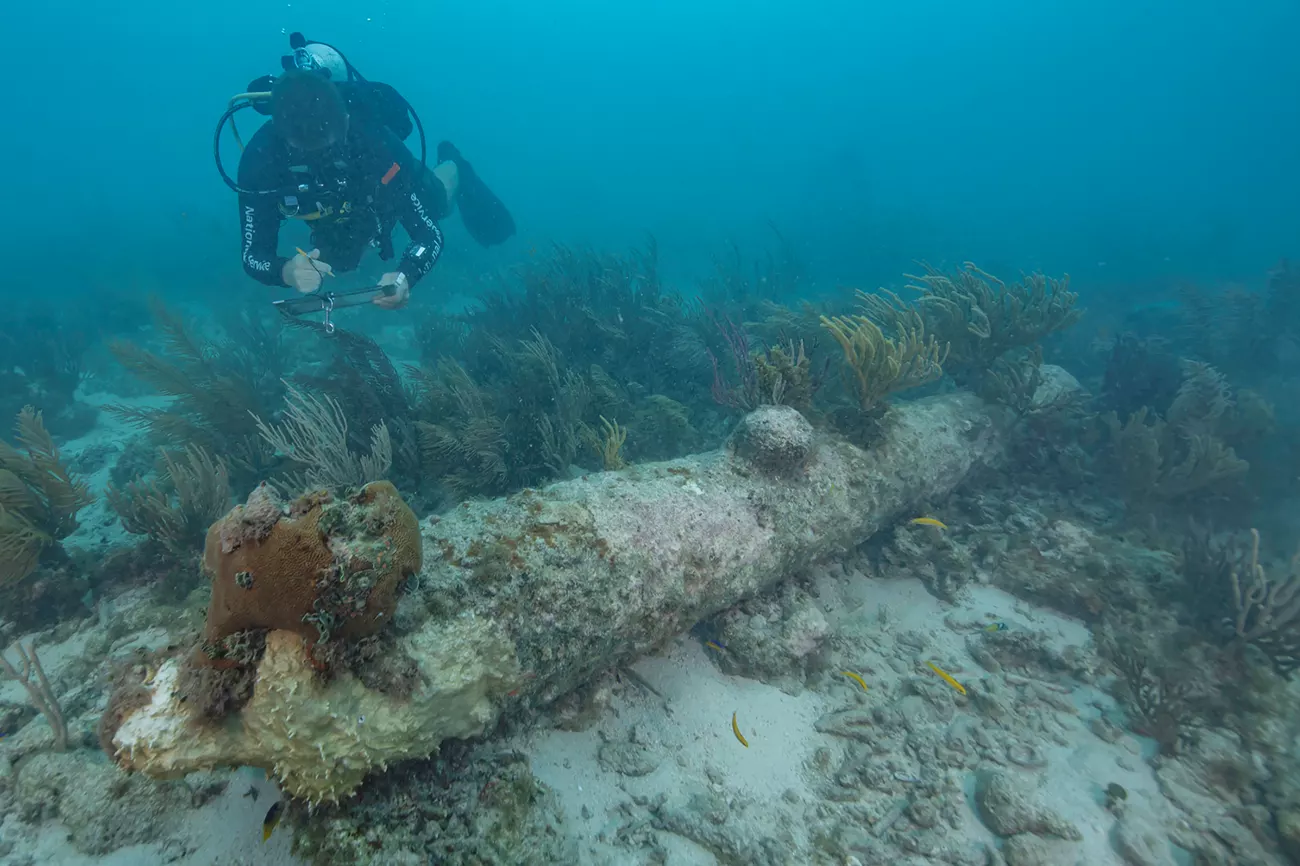Shipwreck discovered at bottom of Florida Keys is revealed to be long-lost British warship
How five submerged cannons and a note in a log book margin helped to identify the whereabouts of HMS Tyger’s remains

The remains of a 300-year-old British warship found 30 years ago in the waters off Florida have finally been identified as belonging to HMS Tyger by US archaeologists.
The Tyger came to rest in a watery grave in the reefs in the Dry Tortugas National Park near the Florida Keys, the National Park Service has announced.
New evidence has determined that the shipwreck remains are that of the gunship after comparing leads from historical research with the artefacts found underwater.
The impressive ship, built in 1647, is believed to have been a 50-gun frigate measuring 130 feet long and weighing 704 tons. Its remains, including cannonballs and cannons and copper barrel bands, have allowed experts to piece together the story of how the vessel sank.
Just under a century after the vessel was launched, it sunk in 1742 after running aground on the reefs of the Dry Tortugas while she was on patrol in the War of Jenkins Ear between Britain and Spain – aptly named after British captain Robert Jenkins who allegedly had his ear cut off by Spanish Coast Guards.
Archaeologists from Dry Tortugas National Park, the Submerged Resources Centre and the Southeast Archeological Center all worked together in surveying the site in 2021.
The experts found five coral-encrusted cannons approximately 500 yards from the main wreck site.
They cross-referenced their mysterious findings with a comment that was hidden in the margins of an old log book, which said the crew “lightened her forward” after they first ran aground, allowing them to briefly refloat the HMS Tyger, but then ended up sinking in the shallow water.
Based on this, they determined that the guns they found were the very same British six and nine-pound cannons that were hurled overboard in their desperation when HMS Tyger ran aground, the park service said.
This finding is a perfect example of how historical records and real-life remains can paint a wider picture of the ship’s story previously lost in history.
“Archeological finds are exciting, but connecting those finds to the historical record helps us tell the stories of the people that came before us and the events they experienced,” park manager James Crutchfield.
“This particular story is one of perseverance and survival. National parks help to protect these untold stories as they come to light.”
The identification has allowed experts to piece together a puzzle of the story of how the crew managed to survive on this isolated island after their ship became a lost cause.
After the ship met its fate in the water and became wrecked while pursuing the Spanish into the Gulf of Mexico, around 300 crew members were marooned for over two months on a small island off the coast of Florida on what is known today as Garden Key.
The crew set up camp and assembled the first fortifications on the island, over 100 years before the island would become the home to Fort Jefferson, which is what Garden Key is known for today.
Fort Jefferson was built in the latter half of the 19th century. It aimed to create an “advance post” for ships patrolling the Gulf of Mexico and the Straits of Florida and, most importantly, fortify one of the most strategic deepwater anchorages in North America, the park service says.
Now, the Garden Key has confirmed another important part of history long before Fort Jefferson was erected.
While stranded on the island, the survivors would have had to endure heat exposure, thirst and swarms of mosquitos, the park service detailed.
They were able to build vessels from pieces they could salvage from the wrecked HMS Tyger and made several tries at seeking help, gathering supplies and even attacking a Spanish ship, but this failed.
In the end, the survivors burned the remains of the Tyger so its guns would not fall into the hands of the enemy. They then used their makeshift vessels to sail 700 miles through enemy waters for 55 days until they reached Port Royal in Jamaica.
While the remains of the historical ship have been found in the US national park, a 2004 law called the Sunken Military Craft Act, means that they are the property of the British government.
The HMS Tyger was the first of three British war vessels to become engulfed in the Florida Keys.
The other two, HMS Fowey and HMS Looe were both identified by archaeologists, yet the Tyger remained mysteriously lost.
However, after further scrutiny of those key ship log books, the new information was able to make a match, and the Tyger was finally found.
Subscribe to Independent Premium to bookmark this article
Want to bookmark your favourite articles and stories to read or reference later? Start your Independent Premium subscription today.

Join our commenting forum
Join thought-provoking conversations, follow other Independent readers and see their replies